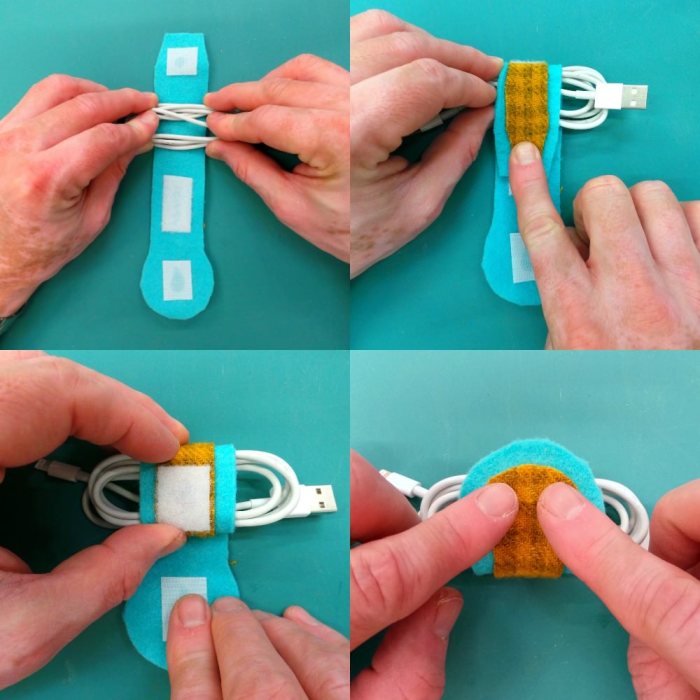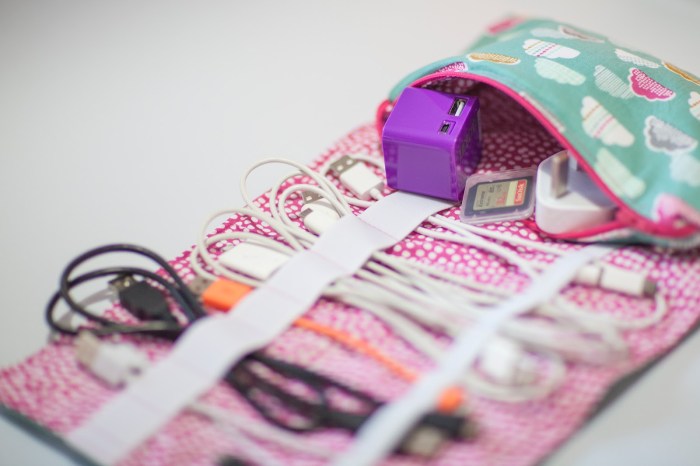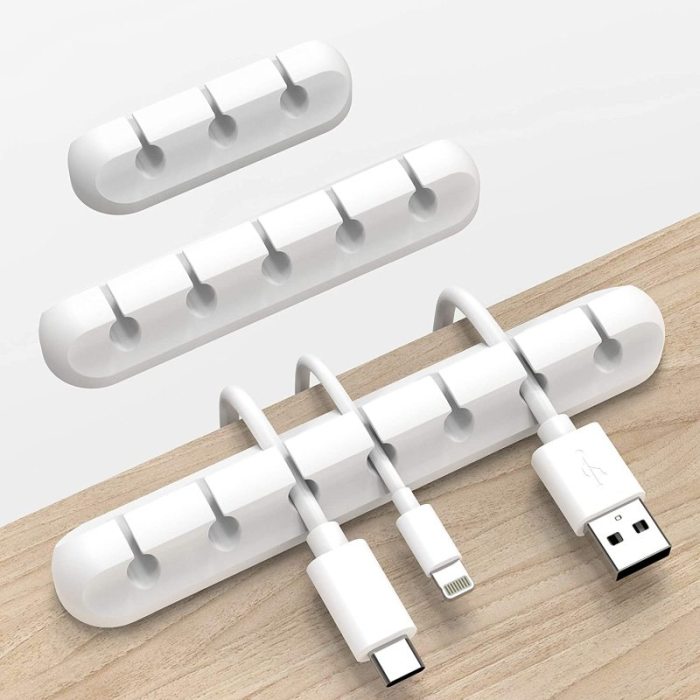DIY Cord Organizer: Tired of tripping over tangled cords and struggling to find the right one? We’ve all been there, and the frustration of cable clutter is a common problem. But fear not, because a well-organized cord system can transform your space, improving aesthetics, safety, and functionality. Imagine a desk free of tangled wires, a living room with neatly hidden cables, and a workspace that’s both efficient and stylish. This guide will provide you with practical DIY solutions to conquer cord chaos and reclaim your space.
From simple cable ties to creative repurposed materials, we’ll explore a range of techniques to manage your cords effectively. Whether you’re tackling a messy desk, a cluttered entertainment center, or a jumbled charging station, these DIY solutions offer a cost-effective and customizable approach to cord organization. Get ready to untangle your life and create a more organized and functional space.
Tips for Efficient Cord Organization

Tangled cords can be a source of frustration, but with a few simple strategies, you can keep your cords organized and easily accessible. Here are some tips for efficiently organizing cords and keeping them untangled.
Labeling Cords
Labeling cords with markers or tags is a simple yet effective way to identify them. This is especially helpful when dealing with multiple devices that use similar cords. Use permanent markers to label the cords directly or use adhesive labels for easy removal and repositioning. You can label the cords with the device they belong to, their function, or any other relevant information. For example, you can label a USB cable as “Laptop USB” or “Printer USB.”
Color-Coded Systems
Color-coding your cords can make them easier to identify and sort. You can use colored electrical tape, cable ties, or even different colored labels. For instance, you could assign a color to each type of cord, such as blue for HDMI cables, green for Ethernet cables, and red for power cords. This color-coding system can be especially helpful in a home office or a workspace with multiple devices.
Grouping Similar Cords
Grouping similar cords together can help to prevent them from getting tangled and can also make them easier to find. You can use cable ties, zip ties, or even rubber bands to bundle similar cords together. For example, you can group all your charging cables for your mobile devices, or all your audio cables together.
Cord Management Techniques for Specific Devices
There are several cord management techniques you can use for specific devices. For example, you can use a cable organizer to keep your desk cords tidy. You can also use a cord wrap to keep your headphone cords from tangling. For your laptop, you can use a laptop stand with built-in cord management features. These techniques can help to keep your cords organized and prevent them from becoming a safety hazard.
Safety Considerations for Cord Organization

A well-organized cord system is not only aesthetically pleasing but also crucial for safety. Improper cord management can create tripping hazards and electrical risks, leading to potential injuries or damage to your devices and property.
Avoiding Overloading Electrical Outlets
Overloading electrical outlets is a significant safety concern. When too many devices are plugged into a single outlet, it can lead to overheating, sparking, and even fire.
- Always check the maximum amperage rating of your outlets and ensure that the total amperage of the plugged-in devices does not exceed this limit.
- Avoid using extension cords as a permanent solution for overloading. They are designed for temporary use and can overheat if used continuously.
- Consider using power strips with built-in circuit breakers that automatically shut off the power if an overload occurs.
Keeping Cords Away from Heat Sources
Heat can damage the insulation of cords, making them more prone to short circuits and fires.
- Avoid placing cords near radiators, stoves, or other heat sources.
- Ensure that cords are not trapped under furniture or rugs, which can generate heat and cause damage.
- When using cords outdoors, protect them from direct sunlight and extreme temperatures.
Ensuring Cords Are Properly Insulated and Protected
Damaged or frayed cords pose a serious electrical hazard.
- Regularly inspect cords for signs of wear and tear, such as cracks, cuts, or exposed wires.
- Replace any damaged cords immediately.
- Use cord protectors or sleeves to protect cords in high-traffic areas or where they might be exposed to sharp edges.
DIY Cord Organizer Inspiration
Looking for creative and practical ways to tame your tangled cords? DIY cord organizers offer a fantastic opportunity to personalize your space while keeping your electronics clutter-free. From simple and budget-friendly solutions to more elaborate projects, the possibilities are endless.
Examples of DIY Cord Organizers
Here are a few inspiring DIY cord organizer projects that you can adapt and personalize for your own needs:
- Cable Management Box: A simple and effective way to conceal cords and keep them organized. You can repurpose an old shoebox, a wooden crate, or even a decorative box. Drill holes in the box for the cords to pass through, and use a label maker to identify each cord.
- DIY Cable Sleeve: Create a stylish and functional cable sleeve by using fabric scraps, felt, or even old t-shirts. Simply cut a strip of fabric, sew the ends together, and then thread your cords through the sleeve.
- Wall-Mounted Cord Organizer: For a more permanent solution, consider building a wall-mounted cord organizer. You can use wood, metal, or even PVC pipe. Cut the material to size and create holes or slots for your cords.
Conclusion

In conclusion, tackling the tangled mess of cords in your home is a rewarding endeavor that brings a multitude of benefits. By embracing DIY cord organization, you not only enhance functionality and aesthetics but also prioritize safety.
The techniques and inspiration shared in this article equip you with the tools to transform your home into a clutter-free haven. From simple cable ties and Velcro straps to more elaborate custom-built solutions, the possibilities are endless.
The Importance of DIY Cord Organization, Diy cord organizer
The importance of DIY cord organization lies in its ability to improve functionality, safety, and aesthetics.
- Enhanced Functionality: By organizing your cords, you streamline your daily routine, making it easier to access and manage your devices. Imagine the frustration of fumbling through a tangled mess of wires every time you need to charge your phone or connect your laptop. DIY cord organization eliminates this frustration, making your tech more accessible and efficient.
- Improved Safety: Untamed cords pose a safety hazard. They can trip you, create fire hazards, and even damage your devices. By organizing your cords, you reduce these risks and create a safer environment for yourself and your family.
- Aesthetic Appeal: Let’s face it, a tangled mess of cords is an eyesore. By organizing your cords, you can create a more aesthetically pleasing and clutter-free environment. A clean and organized space can contribute to a more peaceful and relaxing atmosphere.
By embracing DIY cord organization, you can not only improve the functionality and aesthetics of your space, but also contribute to a safer and more efficient environment. From simple cable ties to innovative repurposed materials, there’s a DIY solution for every cord management need. So, unleash your creativity, explore these techniques, and transform your home or workspace into a haven of organized cords and peace of mind.
Keeping your cords organized can be a real challenge, but it’s a task that’s definitely worth tackling. Just like a well-executed DIY long bob haircut can transform your look, a tidy cord setup can transform your workspace or home. With a little creativity and some basic materials, you can easily create a DIY cord organizer that will keep your electronics looking sleek and organized.
